
Origin of the term
Prairie dogs raise their heads from their burrows in response to disturbances.
Classification and first identification
The black-tailed prairie dog (Cynomys ludovicianus) was first described by Lewis and Clark in 1804.[2] Lewis described it in more detail in 1806, calling it the "barking squirrel".[4]- Order Rodentia
- Suborder Sciuromorpha
- Family Sciuridae (squirrels, chipmunks, marmots, and prairie dogs)
- Subfamily Xerinae
- Genus Cynomys
- Gunnison's prairie dog, Cynomys gunnisoni
- White-tailed prairie dog, Cynomys leucurus
- Black-tailed prairie dog, Cynomys ludovicianus
- Mexican prairie dog, Cynomys mexicanus
- Utah prairie dog, Cynomys parvidens
- About 14 other genera in subfamily
- Genus Cynomys
- Subfamily Xerinae
- Family Sciuridae (squirrels, chipmunks, marmots, and prairie dogs)
Description
Full view of a prairie dog
Ecology and behavior
Diet
Prairie dogs are chiefly herbivorous, though they eat some insects. They feed primarily on grasses and small seeds. In the fall, they eat broadleaf forbs. In the winter, lactating and pregnant females supplement their diets with snow for extra water.[6] They also will eat roots, seeds, fruit, and buds. Grasses of various species are eaten. Black-tailed prairie dogs in South Dakota eat western bluegrass, blue grama, buffalo grass, six weeks fescue, and tumblegrass,[6] while Gunnison’s prairie dogs eat rabbit brush, tumbleweeds, dandelions, saltbush, and cacti in addition to buffalo grass and blue grama. White-tailed prairie dogs have been observed to kill ground squirrels, a competing herbivore.[7][8]Habitat and burrowing
Prairie dogs at a burrow entrance
Prairie dog burrows are 5–10 m (16–33 ft) long and 2–3 m (6.6–9.8 ft) below the ground.[10] The entrance holes are generally 10–30 cm (3.9–11.8 in) in diameter.[10] Prairie dog burrows can have up to six entrances. Sometimes the entrances are simply flat holes in the ground, while at other times they are surrounded by mounds of soil either left as piles or hard packed.[10] Some mounds, known as dome craters, can be as high as 20–30 cm (7.9–11.8 in) high. Other mounds, known as rim craters, can be as high as 1 m.[10] Dome craters and rim craters serve as observation posts used by the animals to watch for predators. They also protect the burrows from flooding. The holes also possibly provide ventilation as the air enters through the dome crater and leaves through the rim crater, causing a breeze though the burrow.[10] Prairie dog burrows contain chambers to provide certain functions. They have nursery chambers for their young, chambers for night, and chambers for the winter. They also contain air chambers that may function to protect the burrow from flooding[9] and a listening post for predators. When hiding from predators, prairie dogs use less-deep chambers that are usually a meter below the surface.[10] Nursery chambers tend to be deeper, being two to three meters below the surface.[10]
Social organization and spacing
Prairie dog family
A pair of prairie dogs
The average prairie dog territory takes up 0.05–1.01 hectares. Territories have well-established borders that coincide with physical barriers such as rocks and trees.[10] The resident male of a territory defends it and antagonistic behavior will occur between two males of different families to defend their territories. These interactions may happen 20 times per day and last five minutes. When two prairie dogs encounter each other at the edges of their territories, they will start staring, make bluff charges, flare their tails, chatter their teeth, and sniff each other's perianal scent glands. When fighting, prairie dogs will bite, kick and ram each other.[10] If their competitor is around their size or smaller, the females will participate in fighting. Otherwise, if a competitor is sighted, the females signal for the resident male.
Reproduction and parenting
Female with juvenile
Juvenile prairie dogs
Antipredator calls
Prairie dog calling
Alarm response behavior varies according to the type of predator announced. If the alarm indicates a hawk diving toward the colony, all the prairie dogs in its flight path dive into their holes, while those outside the flight path stand and watch. If the alarm is for a human, all members of the colony immediately rush inside the burrows. For coyotes, the prairie dogs move to the entrance of a burrow and stand outside the entrance, observing the coyote, while those prairie dogs that were inside the burrows will come out to stand and watch as well. For domestic dogs, the response is to observe, standing in place where they were when the alarm was sounded, again with the underground prairie dogs emerging to watch.[15]
There is debate over whether the alarm calling of prairie dogs is selfish or altruistic. It is possible that prairie dogs alert others to the presence of a predator so they can protect themselves. However, it is also possible that the calls are meant to cause confusion and panic in the groups and cause the others to be more conspicuous to the predator than the caller. Studies of black-tailed prairie dogs suggest that alarm-calling is a form of kin selection, as a prairie dog’s call alerts both offspring and nondescended kin, such as cousins, nephews and nieces.[10] Prairie dogs with kin close by called more often than those that did not have kin nearby. In addition, the caller may be trying to make itself more noticeable to the predator.[10] Predators, though, seem to have difficulty determining which prairie dog is making the call due to its "ventriloquistic" nature.[10]
Perhaps the most striking of prairie dog communications is the territorial call or "jump-yip" display of the black-tailed prairie dog.[16] A black-tailed prairie dog will stretch the length of its body vertically and throw its forefeet into the air while making a call. A jump-yip from one prairie dog causes others nearby to do the same.[17]
Conservation status
A prairie dog and his hole
Nevertheless, prairie dogs are often identified as pests and exterminated from agricultural properties because they are capable of damaging crops, as they clear the immediate area around their burrows of most vegetation.[19]
A black-tailed prairie dog forages above ground for grasses and leaves.
One common concern which led to the widespread extermination of prairie dog colonies was that their digging activities could injure horses[23] by fracturing their limbs. However, according to writer Fred Durso, Jr., of E Magazine, "after years of asking ranchers this question, we have found not one example."[24] Another concern is their susceptibility to bubonic plague.[25] As of July 2016 the U.S. Fish and Wildlife Service plans to distribute an oral vaccine it had developed by unmanned aircraft or drones.[26]
In captivity
South-central Wisconsin, U.S.
They can be difficult pets to care for, requiring regular attention and a very specific diet of grasses and hay. Each year, they go into a period called rut that can last for several months, in which their personalities can drastically change, often becoming defensive or even aggressive. Despite their needs, prairie dogs are very social animals and come to seem as though they treat humans as members of their colony, answering barks and chirps, and even coming when called by name.[citation needed]
In mid-2003, due to cross-contamination at a Madison, Wisconsin-area pet swap from an unquarantined Gambian pouched rat imported from Ghana, several prairie dogs in captivity acquired monkeypox, and subsequently a few humans were also infected. This led the CDC and FDA to issue a joint order banning the sale, trade, and transport within the United States of prairie dogs (with a few exceptions).[30] The disease was never introduced to any wild populations. The European Union also banned importation of prairie dogs in response.[31]
All Cynomys species are classed as a "prohibited new organism" under New Zealand's Hazardous Substances and New Organisms Act 1996, preventing it from being imported into the country.[32]
Prairie dogs are also very susceptible to bubonic plague, and many wild colonies have been wiped out by it.[33][34][35][36] Also, in 2002, a large group of prairie dogs in captivity in Texas were found to have contracted tularemia.[37] The prairie dog ban is frequently cited by the CDC as a successful response to the threat of zoonosis.[38]
Prairie dogs that were in captivity at the time of the ban in 2003 were allowed to be kept under a grandfather clause, but were not to be bought, traded, or sold, and transport was permitted only to and from a veterinarian under quarantine procedures.[39]
On 8 September 2008, the FDA and CDC rescinded the ban, making it once again legal to capture, sell, and transport prairie dogs.[40] Although the federal ban has been lifted, several states still have in place their own ban on prairie dogs.[41]
The European Union has not lifted its ban on imports from the U.S. of animals captured in the wild. Major European Prairie Dog Associations, such as the Italian Associazione Italiana Cani della Prateria (AICDP), remain against import from the United States, due to the high death rate of wild captures.[42][43] Several zoos in Europe have stable prairie dog colonies that generate enough surplus pups to saturate the EU internal demand, and several associations help owners to give adoption to captive-born animals.[44]
Prairie dogs in captivity may live up to ten years.[45]
Literary descriptions
- From George Wilkins Kendall's account of the Texan Santa Fe Expedition: "In their habits, they are clannish, social, and extremely convivial, never living alone like other animals, but, on the contrary, always found in villages or large settlements. They are a wild, frolicsome, madcap set of fellows when undisturbed, uneasy and ever on the move, and appear to take especial delight in chattering away the time, and visiting from hole to hole to gossip and talk over each other's affairs—at least so their actions would indicate. On several occasions I crept close to their villages, without being observed, to watch their movements. Directly in the centre of one of them I particularly noticed a very large dog, sitting in front of the door or entrance to his burrow, and by his own actions and those of his neighbors it really seemed as though he was the president, mayor, or chief—at all events, he was the 'big dog' of the place. For at least an hour I secretly watched the operations in this community. During that time the large dog I have mentioned received at least a dozen visits from his fellow-dogs, which would stop and chat with him a few moments, and then run off to their domiciles. All this while he never left his post for a moment, and I thought I could discover a gravity in his deportment not discernible in those by which he was surrounded. Far is it from me to say that the visits he received were upon business, or had anything to do with the local government of the village; but it certainly appeared so. If any animal has a system of laws regulating the body politic, it is certainly the prairie dog."[46]
"Dog Town" or settlement of prairie dogs
- From Josiah Gregg's journal, Commerce of the Prairies: "Of all the prairie animals, by far the most curious, and by no means the least celebrated, is the little prairie dog. ...The flesh, though often eaten by travelers, is not esteemed savory. It was denominated the 'barking squirrel', the 'prairie ground-squirrel', etc., by early explorers, with much more apparent propriety than the present established name. Its yelp, which resembles that of the little toy-dog, seems its only canine attribute. It rather appears to occupy a middle ground betwixt the rabbit and squirrel—like the former in feeding and burrowing — like the latter in frisking, flirting, sitting erect, and somewhat so in its barking. The prairie dog has been reckoned by some naturalists a species of the marmot (arctomys ludoviciana); yet it seems to possess scarce any other quality in common with this animal except that of burrowing. ...I have the concurrent testimony of several persons, who have been upon the Prairies in winter, that, like rabbits and squirrels, they issue from their holes every soft day; and therefore lay up no doubt a hoard of 'hay' (as there is rarely anything else to be found in the vicinity of their towns) for winter's use. A collection of their burrows has been termed by travelers a 'dog town,' which comprises from a dozen or so, to some thousands in the same vicinity; often covering an area of several square miles. They generally locate upon firm dry plains, coated with fine short grass, upon which they feed; for they are no doubt exclusively herbivorous. But even when tall coarse grass surrounds, they seem commonly to destroy this within their 'streets,' which are nearly always found 'paved' with a fine species suited to their palates. They must need but little water, if any at all, as their 'towns' are often, indeed generally, found in the midst of the most arid plains—unless we suppose they dig down to subterranean fountains. At least they evidently burrow remarkably deep. Attempts either to dig or drown them out of their holes have generally proved unsuccessful. Approaching a 'village,' the little dogs may be observed frisking about the 'streets'—passing from dwelling to dwelling apparently on visits—sometimes a few clustered together as though in council—here feeding upon the tender herbage—there cleansing their 'houses,' or brushing the little hillock about the door—yet all quiet. Upon seeing a stranger, however, each streaks it to its home, but is apt to stop at the entrance, and spread the general alarm by a succession of shrill yelps, usually sitting erect. Yet at the report of a gun or the too near approach of the visitor, they dart down and are seen no more till the cause of alarm seems to have disappeared.[47]

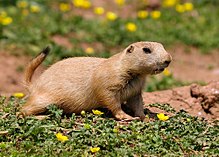
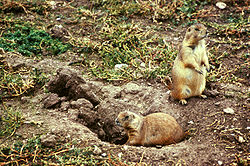

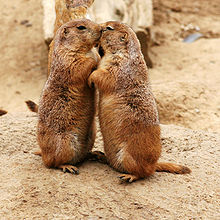
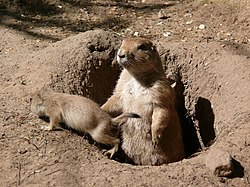

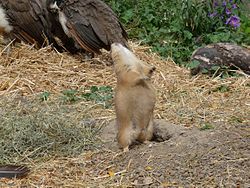






No comments:
Post a Comment
Note: Only a member of this blog may post a comment.